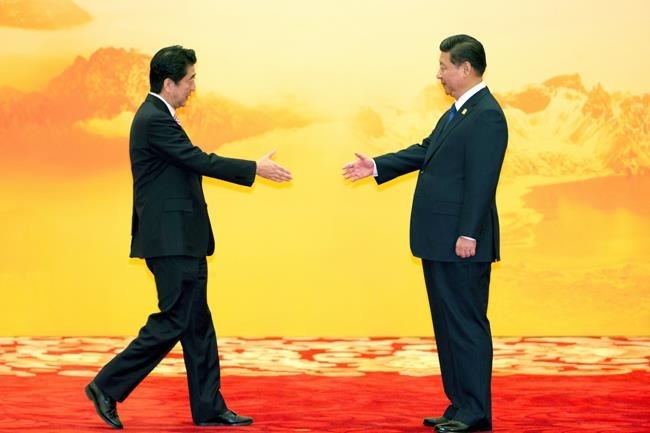
FILE - In this Nov. 11, 2014, file photo, Japan's Prime Minister Shinzo Abe reaches out to shake hands with Chinese President Xi Jinping during a regional economic meeting in Yanqi Lake, Beijing. Asia’s two major regional meetings are unfolding in coming days, filling the news cycles with imagery of groups of political luminaries greeting and meeting, its usually in the “bilats” – the “bilateral meetings ” between ministers or leaders that take place on the sidelines of meetings like APEC and ASEAN, both of which are happening late this week and early next. (AP Photo/Ng Han Guan, File)
Republished November 10, 2017 - 5:48 AM
Original Publication Date November 10, 2017 - 1:06 AM
DANANG, Vietnam - Asia's two major regional meetings are unfolding in coming days, filling the news cycles with imagery of groups of political luminaries shaking hands, posing, dining, meeting. But is that where the majority of real progress happens? Most times, quite possibly not.
Much happens in "bilats" — the "bilateral," one-on-one meetings between ministers or leaders that take place on the sidelines of meetings like APEC and ASEAN, both of which are happening late this week and early next.
A meeting between Donald Trump and Vladimir Putin on the sidelines of APEC in Vietnam on Friday or Saturday, for example, would be a classic "bilat." (Although the two have said they won't meet formally, they haven't ruled out an informal encounter.)
Bilats on the sidelines of regional meetings are significant because they allow leaders — particularly those who might have some tension between them — to meet and talk in a place where they already are.
So, for example, if you're running a country that's not getting along great with another country — to the point where a state visit would be awkward and unlikely — significant progress can be made in brief meetings at a regional summit. The stakes might be a bit lower and the pressure a bit less.
Among the assortment of bilats so far this week at APEC: Canada's Justin Trudeau met with Japan's Shinzo Abe as well as Mexican President Enrique Peña Nieto, and Philippine President Rodrigo Duterte was meeting with Putin and Chinese President Xi Jinping.
U.S. President Donald Trump is expected to place higher significance on bilats this week given his decision to withdraw from the Trans-Pacific Partnership, a regional effort to liberalize and emphasize regional trade.
Instead, he has said he prefers bilateral agreements with individual nations, thus raising the stakes of U.S.-driven bilats at APEC and ASEAN in coming days. Other TPP stakeholders, meanwhile, are still pursuing a group effort without Washington's involvement.
And when even a bilat is too much? There's also the "pull-aside," in which two leaders attending a dinner or a ceremonial part of the regional meeting simply walk off into a corner or a side room for a brief tete-a-tete. A pull-aside is one of the lowest forms of gatherings in diplomacy that's sometimes used by countries like China and the U.S. to send a signal that all's not well in a relationship.
News from © The Associated Press, 2017